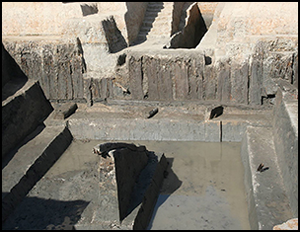Crossref Citations
This article has been cited by the following publications. This list is generated based on data provided by
Crossref.
Vaiglova, Petra
Reid, Rachel E. B.
Lightfoot, Emma
Pilaar Birch, Suzanne E.
Wang, Hui
Chen, Guoke
Li, Shuicheng
Jones, Martin
and
Liu, Xinyi
2021.
Localized management of non-indigenous animal domesticates in Northwestern China during the Bronze Age.
Scientific Reports,
Vol. 11,
Issue. 1,
Wang, Xueye
Roberts, Patrick
Tang, Zihua
Yang, Shiling
Storozum, Michael
Groß, Marcus
and
Fernandes, Ricardo
2021.
The Circulation of Ancient Animal Resources Across the Yellow River Basin: A Preliminary Bayesian Re-evaluation of Sr Isotope Data From the Early Neolithic to the Western Zhou Dynasty.
Frontiers in Ecology and Evolution,
Vol. 9,
Issue. ,
Zhang, Quan
Hou, Yanfeng
Li, Xinwei
Styring, Amy
Lee-Thorp, Julia
and
Biehl, Peter F.
2021.
Stable isotopes reveal intensive pig husbandry practices in the middle Yellow River region by the Yangshao period (7000–5000 BP).
PLOS ONE,
Vol. 16,
Issue. 10,
p.
e0257524.
Dai, Lingling
and
Zhang, Dong
2021.
Pig management strategies during the early Dawenkou cultural period (ca. 6200–5600 BP): A stable isotopic analysis of animal remains from the Houtieying site, Anhui Province, China.
Quaternary International,
Vol. 595,
Issue. ,
p.
88.
2021.
ANNUAL BIBLIOGRAPHY.
Early China,
Vol. 44,
Issue. ,
p.
555.
Hongo, Hitomi
Kikuchi, Hiroki
and
Nasu, Hiroo
2021.
Beginning of pig management in Neolithic China: comparison of domestication processes between northern and southern regions.
Animal Frontiers,
Vol. 11,
Issue. 3,
p.
30.
Bogaard, Amy
Allaby, Robin
Arbuckle, Benjamin S.
Bendrey, Robin
Crowley, Sarah
Cucchi, Thomas
Denham, Tim
Frantz, Laurent
Fuller, Dorian
Gilbert, Tom
Karlsson, Elinor
Manin, Aurélie
Marshall, Fiona
Mueller, Natalie
Peters, Joris
Stépanoff, Charles
Weide, Alexander
and
Larson, Greger
2021.
Reconsidering domestication from a process archaeology perspective.
World Archaeology,
Vol. 53,
Issue. 1,
p.
56.
Tang, Yiyi
Marston, John M
and
Fang, Xiangming
2022.
Early millet cultivation, subsistence diversity, and wild plant use at Neolithic Anle, Lower Yangtze, China.
The Holocene,
Vol. 32,
Issue. 10,
p.
1003.
Horsburgh, K. Ann
Gosling, Anna L.
Cochrane, Ethan E.
Kirch, Patrick V.
Swift, Jillian A.
and
McCoy, Mark D.
2022.
Origins of Polynesian Pigs Revealed by Mitochondrial Whole Genome Ancient DNA.
Animals,
Vol. 12,
Issue. 18,
p.
2469.
Lv, Xiaohong
Ban, Lin
Liu, Yiwen
Guan, Ying
Liu, Hailin
Wang, Chunxue
and
Hou, Liangliang
2022.
Pig Management Strategies in the East Liao River Basin From the Bronze Age (c. 2000–256 BC) to the Liaojin Dynasties (907–1234 AD): Stable Isotope Analysis of Animals at the Changshan Site, Jilin Province, China.
Frontiers in Earth Science,
Vol. 10,
Issue. ,
Zhang, Ming
Liu, Yichen
Li, Zhipeng
Lü, Peng
Gardner, Jacob D.
Ye, Maolin
Wang, Jihuai
Yang, Miaomiao
Shao, Jing
Wang, Weilin
Dai, Qingyan
Cao, Peng
Yang, Ruowei
Liu, Feng
Feng, Xiaotian
Zhang, Lizhao
Li, Enwei
Shi, Yunzheng
Chen, Zehui
Zhu, Shilun
Zhai, Weiwei
Deng, Tao
Duan, Ziyuan
Bennett, E. Andrew
Hu, Songmei
and
Fu, Qiaomei
2022.
Ancient DNA reveals the maternal genetic history of East Asian domestic pigs.
Journal of Genetics and Genomics,
Vol. 49,
Issue. 6,
p.
537.
Brunson, Katherine
and
Lander, Brian
2023.
Deer and Humans in the Early Farming Communities of the Yellow River Valley: A Symbiotic Relationship.
Human Ecology,
Vol. 51,
Issue. 4,
p.
609.
Jaffe, Yitzchak
2023.
Food in Ancient China.
Stock, Jay T.
Pomeroy, Emma
Ruff, Christopher B.
Brown, Marielle
Gasperetti, Matthew A.
Li, Fa-Jun
Maher, Lisa
Malone, Caroline
Mushrif-Tripathy, Veena
Parkinson, Eóin
Rivera, Michael
Siew, Yun Ysi
Stefanovic, Sofija
Stoddart, Simon
Zariņa, Gunita
and
Wells, Jonathan C. K.
2023.
Long-term trends in human body size track regional variation in subsistence transitions and growth acceleration linked to dairying.
Proceedings of the National Academy of Sciences,
Vol. 120,
Issue. 4,
Dong, Ningning
Sun, Chen
Zhu, Xuchu
Tian, Xiaohong
Wu, Yong
Luo, Yahao
Zhou, Yuxuan
and
Yuan, Jing
2023.
Life on the edge: Animal exploitation at the Shichengzi military fort (Xinjiang, China).
International Journal of Osteoarchaeology,
Vol. 33,
Issue. 3,
p.
546.
You, Yue
Chen, Xianglong
Hein, Anke
Qin, Cunyu
Zhao, Yanan
Zhang, Jiaxin
Liu, Tianyang
Fan, Wenquan
and
Yuan, Guangkuo
2024.
Pig domestication and human subsistence at the early Neolithic site of Guanjia (6100–5500 BC), Central China.
Archaeological and Anthropological Sciences,
Vol. 16,
Issue. 3,
Festa, Marcella
Wu, Miao
Qin, Gaomin
Qiao, Batong
Wang, Wei
Xian, Yiheng
Monteith, Francesca
and
Yu, Chun
2024.
Animal use in Han dynasty cities: Zooarchaeological evidence from Yishengci, Nanyang (China).
Archaeological Research in Asia,
Vol. 38,
Issue. ,
p.
100514.
Liu, Yifei
Huang, Yucheng
Gan, Huiyuan
and
Dong, Ningning
2024.
Herding or Hunting? Animal Exploitation at Jiangzhuang (Jiangsu, China) During the Liangzhu Period (3300–2300 BC).
Animals,
Vol. 14,
Issue. 23,
p.
3461.
Zhuang, Yijie
and
Fuller, Dorian Q
2024.
Landscape of Loess, Millets, and Boar.
Current Anthropology,
Vol. 65,
Issue. S26,
p.
S3.
Yang, Jishuai
Wang, Linying
Tsring, Tinley
Li, Ting
Chen, Shungang
Huang, Yunzhe
Yang, Qi
Wang, Qing
You, Ting
Tian, Yaofei
Wangdue, Shargan
Tsring, Tashi
Chen, Zujun
Chen, Songtao
Jia, Nihanxue
Sheng, Guilian
Gao, Yu
and
Yang, Xiaoyan
2024.
Early intensive millet-pig agriculture in the high-elevation Tibetan Plateau.
Quaternary Science Reviews,
Vol. 345,
Issue. ,
p.
109048.


